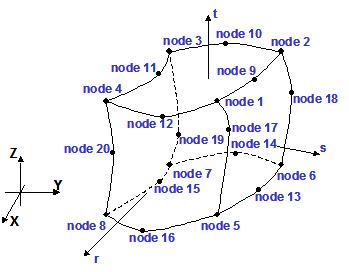The element is used to construct a twenty-node three dimensional element object
element Brick20N $eletag $node1 $node2 $node3 $node4 $node5 $node6 $node7 $node8 $node9 $node10 $node11 $node12 $node13 $node14 $node15 $node16 $node17 $node18 $node19 $node20 $matTag $bf1 $bf2 $bf3 $massDen
$eletag |
unique element object tag |
$node1 $node2 $node3 $node4 $node5 $node6 $node7 $node8 $node9 $node10 $node11 $node12 $node13 $node14 $node15 $node16 $node17 $node18 $node19 $node20 |
twenty node coordinates, input order is shown in the figure |
$matTag |
material tag associated with previsouly-defined NDMaterial object |
$bf1 $bf2 $bf3 |
body force in the direction of global coordinates x, y and z |
$massDen |
mass density (mass/volume) |
The valid queries to a Brick20N element when creating an ElementRecorder object are 'force,' 'stiffness,' stress', 'gausspoint' or 'plastic'. The output is given as follows:
'stress' |
the six stress components from each Gauss points are output by the order: sigma_xx, sigma_yy, sigma_zz, sigma_xy, sigma_xz,sigma_yz |
'gausspoint' |
the coordinates of all Gauss points are printed out |
'plastic' |
the equivalent deviatoric plastic strain from each Gauss point is output in the same order as the coordinates are printed |
